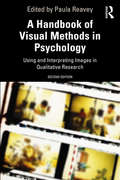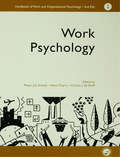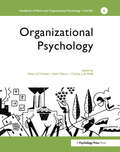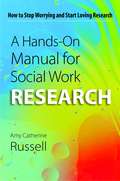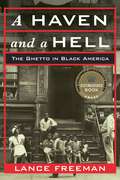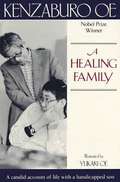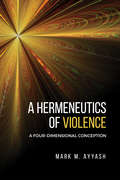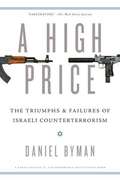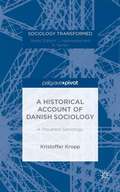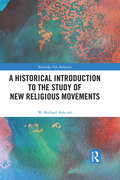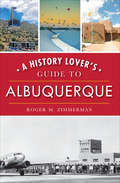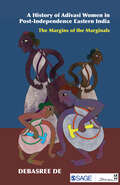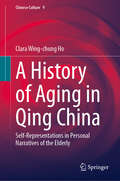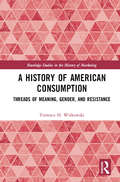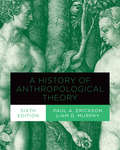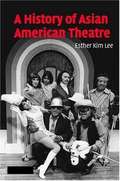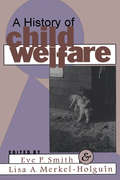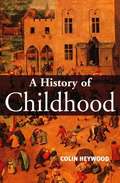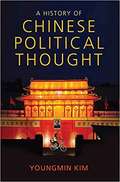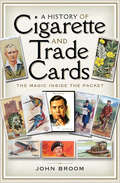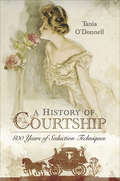- Table View
- List View
A Handbook of Visual Methods in Psychology: Using and Interpreting Images in Qualitative Research
by Paula ReaveyThis comprehensive volume explores the set of theoretical, methodological, ethical and analytical issues that shape the ways in which visual qualitative research is conducted in psychology. Using visual data such as film making, social media analyses, photography and model making, the book uniquely uses visual qualitative methods to broaden our understanding of experience and subjectivity. In recent years, visual research has seen a growing emphasis on the importance of culture in experience-based qualitative methods. Featuring contributors from diverse research backgrounds including narrative psychology, personal construct theory and psychoanalysis, the book examines the potential for visual methods in psychology. In each chapter of the book, the contributors explore and address how a visual approach has contributed to existing social and psychological theory in their line of research. The book provides up-to-date insights into combining methods to create new multi-modal methodologies, and analyses these with psychology-specific questions in mind. It covers topics such as sexuality, identity, group processes, child development, forensic psychology, race and gender, and would be the ideal companion for those studying or undertaking research in disciplines like psychology, sociology and gender studies.
A Handbook of Work and Organizational Psychology: Volume 2: Work Psychology (Handbook Of Work And Organizational Psychology Ser. #Vol. 3)
by Henk Thierry Pieter J.D. Drenth Charles J. de WolffWork Psychology, the second volume of the Handbook of Work and Organizational Psychology, concentrates on issues related to the direct relationship between the worker and the organization and on his or her task or function. This could be termed the classical tradition of work psychology, including human factors, psychology and ergonomics. This volume provides a comprehensive update on new issues and studies in this core area. Subjects like safety, occupational stress, workload and absenteeism due to sickness are tackled. Chapters discuss particular types of workers on whom psychologists have focused attention more recently: the older worker, the unemployed, and the foreign worker. Moving away somewhat from the 'micro-world' of the individual worker, models of human economic behaviour and the development of social indicator systems are also explored.
A Handbook of Work and Organizational Psychology: Volume 3: Personnel Psychology (Handbook Of Work And Organizational Psychology Ser. #Vol. 3)
by Henk Thierry Pieter J.D. Drenth Charles J. de WolffPersonnel Psychology (or Human Resource Management) examines individual differences and their consequences for the organization. Attention is paid to choice processes, abilities and capabilities, needs and need fulfilment, commitment, selection methods, career development, appraisal and training. The focus of personnel psychology is the satisfactory relationship between the employee and the organization, and takes in all the elements influencing this relationship ranging from the traditional area of personnel selection to recent considerations, such as conflict between client demands and government regulations, restriction of output, job evaluation practices, and industrial unrest.
A Handbook of Work and Organizational Psychology: Volume 4: Organizational Psychology (Handbook Of Work And Organizational Psychology Ser. #Vol. 3)
by Henk Thierry Pieter J.D. Drenth Charles J. de WolffOrganizational processes and the organization-environment interaction are discussed in this volume of the Handbook of Work and Organizational Psychology. Both organizational and environmental characteristics affect the behaviour of individuals and groups, but such characteristics are in turn also influenced by behavioural features. This volume on organizational psychology covers subject areas such as organization theory, organizational culture and change, leadership, decision making and participation, motivation and satisfaction, payment systems, effective communication, and social-organizational aspects of automation. The final chapter describes the impact upon behaviour and attitudes of the transition of a socialist-led society to a market economy.
A Hands-on Manual For Social Work Research: How To Stop Worrying And Start Loving Research
by Amy Catherine RussellA hands-on approach to teaching research that overcomes the resistance of the most apprehensive student.
A Haven and a Hell: The Ghetto in Black America
by Lance FreemanThe black ghetto is thought of as a place of urban decay and social disarray. Like the historical ghetto of Venice, it is perceived as a space of confinement, one imposed on black America by whites. It is the home of a marginalized underclass and a sign of the depth of American segregation. Yet while black urban neighborhoods have suffered from institutional racism and economic neglect, they have also been places of refuge and community.In A Haven and a Hell, Lance Freeman examines how the ghetto shaped black America and black America shaped the ghetto. Freeman traces the evolving role of predominantly black neighborhoods in northern cities from the late nineteenth century through the present day. At times, the ghetto promised the freedom to build black social institutions and political power. At others, it suppressed and further stigmatized African Americans. Freeman reveals the forces that caused the ghetto’s role as haven or hell to wax and wane, spanning the Great Migration, mid-century opportunities, the eruptions of the sixties, the challenges of the seventies and eighties, and present-day issues of mass incarceration, the subprime crisis, and gentrification. Offering timely planning and policy recommendations based in this history, A Haven and a Hell provides a powerful new understanding of urban black communities at a time when the future of many inner-city neighborhoods appears uncertain.
A Healing Family: A Candid Account of Life with a Handicapped Son
by Stephen Snyder Kenzaburo OëA Healing Family, Kenzaburo Oë's first book since winning the Nobel Prize for Literature, is an intimate portrait of the people closest to him. Above all, it is about his son Hikari. Hikari was born in 1963 with a growth on his brain so large it made him look as if he had two heads. His parents were told he might never be more than a "human vegetable" requiring constant care; but they took the decision to raise him. Today, despite autism, poor vision, and a tendency to seizures, their son is an established composer with two successful CDs to his credit. Oë has often written about the sorrows and satisfactions of being the parent of a handicapped child, most memorably in A Personal Matter; but nowhere has his writing been more personal, more buoyant, more revealing than in this non-fiction work. Without diminishing the suffering that Hikari and his family have been through, he celebrates the victories that can be won, especially his son's gift for music--his own "language." Friends make an appearance along the way--doctors, musicians, other writers--as do the themes that have preoccupied Oë all his life: the rights of the underprivileged; the moral authority of the survivors of the atomic bombing; the mystery of language. But his thoughts keep circling back to his family--to the healing power of the family, and the unwitting courage we can all find in ourselves.
A Hermeneutics of Violence: A Four-Dimensional Conception
by Mark M. AyyashAttention to the elusiveness of violence opens up a rich landscape of analysis, whereby social scientists can examine the often-overlooked transformative dimensions of violent acts. Theories of violence are numerous today, but because of the mysterious nature of violence, and how each individual or group may endure it uniquely, its study cannot be limited to one specialized and highly restricted field. A Hermeneutics of Violence seeks to remedy this problem by placing in dialogue various theories of violence from the disciplines of anthropology, sociology, international relations, and philosophy. This study uses a four-dimensional lens to examine the many facets of violence, including its instrumental, linguistic, mimetic, and transcendental dimensions. Far from irreconcilable, these positions, when placed within a four-dimensional outlook, open up new avenues for the study of particular cases of violence. Exploring the complex interactions, for instance, of "enemy-siblings," Mark M. Ayyash reveals "postures of incommensurability" that continuously produce conflictual positions across a spectrum of time and space and demand the release of violence. The book concludes that these postures must be understood and deconstructed before we can have a legitimate chance to achieve peace and justice, the conceptions of which must come with the intent of not necessarily opposing violence but rather replacing our conceptions of what the violences have come to constitute as "real."
A High Price: The Triumphs and Failures of Israeli Counterterrorism
by Daniel BymanThe product of painstaking research and countless interviews, A High Price offers a nuanced, definitive historical account of Israel's bold but often failed efforts to fight terrorist groups. Beginning with the violent border disputes that emerged after Israel's founding in 1948, Daniel Byman charts the rise of Yasir Arafat's Fatah and leftist groups such as the Popular Front for the Liberation of Palestine--organizations that ushered in the era of international terrorism epitomized by the 1972 hostage-taking at the Munich Olympics. Byman reveals how Israel fought these groups and others, such as Hamas, in the decades that follow, with particular attention to the grinding and painful struggle during the second intifada. Israel's debacles in Lebanon against groups like the Lebanese Hizballah are examined in-depth, as is the country's problematic response to Jewish terrorist groups that have struck at Arabs and Israelis seeking peace. In surveying Israel's response to terror, the author points to the coups of shadowy Israeli intelligence services, the much-emulated use of defensive measures such as sky marshals on airplanes, and the role of controversial techniques such as targeted killings and the security barrier that separates Israel from Palestinian areas. Equally instructive are the shortcomings that have undermined Israel's counterterrorism goals, including a disregard for long-term planning and a failure to recognize the long-term political repercussions of counterterrorism tactics.
A Historical Account of Danish Sociology: A Troubled Sociology (Sociology Transformed)
by Kristoffer KroppThis book provides the first English-language account of the history of Danish sociology, examining it from the late 19th century to the present day. Focusing on the discipline's struggle for recognition in Denmark, it is a case study of how sociological knowledge has entered into ever-changing coalitions with welfare state bureaucracies.
A Historical Introduction to the Study of New Religious Movements (Routledge New Religions)
by W. Michael AshcraftThe American public’s perception of New Religious Movements (NRMs) as fundamentally harmful cults stems from the "anticult" movement of the 1970s, which gave a sometimes hysterical and often distorted image of NRMs to the media. At the same time, academics pioneered a new field, studying these same NRMs from sociological and historical perspectives. They offered an interpretation that ran counter to that of the anticult movement. For these scholars in the new field of NRM studies, NRMs were legitimate religions deserving of those freedoms granted to established religions. Those scholars in NRM studies continued to evolve methods and theories to study NRMs. This book tells their story. Each chapter begins with a biography of a key person involved in studying NRMs. The narrative unfolds chronologically, beginning with late nineteenth- and early-twentieth century perceptions of religions alternative to the mainstream. Then the focus shifts to those early efforts, in the 1960s and 1970s, to comprehend the growing phenomena of cults or NRMs using the tools of academic disciplines. The book’s midpoint is a chapter that looks closely at the scholarship of the anticult movement, and from there moves forward in time to the present, highlighting themes in the study of NRMs like violence, gender, and reflexive ethnography. No other book has used the scholars of NRMs as the focus for a study in this way. The material in this volume is, therefore, a fascinating viewpoint from which to explore the origins of this vibrant academic community, as well as analyse the practice of Religious Studies more generally.
A History Lover's Guide to Albuquerque
by Roger M. ZimmermanA landmark-by-landmark tour of New Mexico&’s largest city, with photos and facts on its fascinating past. This tour of Albuquerque, New Mexico, goes beyond the traditional guidebook to offer a historical journal detailing an area rich with diverse cultures and dramatic events. The journey through time starts with the settlement of Native Americans in pueblos along the Rio Grande and then initiatives by Spain to settle and convert the region. Visit Old Town Plaza, where trade from the El Camino Real and Santa Fe Trails flourished. Look around lesser-known sites, including railroad depot facilities, major military landmarks and nostalgic Route 66. Join local history expert Roger Zimmerman as he carefully curates an expedition through each era of Albuquerque&’s history and its most beloved sites
A History of Adivasi Women in Post-Independence Eastern India: The Margins of the Marginals
by Debasree DeA history of the historyless, and the marginalization of adivasi voices. A History of Adivasi Women in Post-Independence Eastern India is a path-breaking book that explores the current status of adivasi women in the four states of eastern India with high percentages of adivasis—Bihar, Jharkhand, Odisha and West Bengal. Debasree De engages with the recent paradigm of ‘development and displacement’ and adivasi women’s marginalization and cultural silencing. The findings in the book are based on extensive field surveys in teagardens, stone crushing sites, brick kilns and construction industries. Further, the book provides new material on the extremist villages of Jangal Mahal, Koraput, Malkangiri and Niyamgiri Hills. Linking tribe and gender, the author elaborates how forest economy is women’s economy; forcible eviction by multinationals for new industries has led to severe displacement and poverty, apart from intensification of witch hunting and trafficking of girls.
A History of Aging in Qing China: Self-Representations in Personal Narratives of the Elderly (Chinese Culture #9)
by Clara Wing-chung HoThis book examines the history of aging and old age during the Qing dynasty, a pivotal period marked by rapid population growth that resulted in the largest elderly population in imperial China. Drawing on previously overlooked first-person accounts from the extensive collections authored by Qing men and women, it offers an overview of the self-curated collective aging journeys of several hundreds of elders. By centering the voices of individuals reflecting on their aging experiences, this book delves into the personal narratives from both genders, rediscovering their aging journeys, revealing their subjectively constructed emotional landscapes, and giving a voice to the elderly individuals of the past. The chapters closely analyze how the elderly in Qing China articulated their aging process, channeling their joys, challenges, and frustrations in later life. History is not the monopoly of a single gender, class, race, or age group; without representations of the elderly, history remains incomplete. This book seeks to restore the elderly to the historical narrative and invites further discussion on Chinese historical gerontology as an emerging subfield. In addition to appealing to general readers interested in contemporary demographic issues from a historical perspective, this book will engage students and researchers of history, historical gerontology, aging studies, gender studies, cultural studies, sociology, psychology, and Asian studies.
A History of American Consumption: Threads of Meaning, Gender, and Resistance (Routledge Studies in the History of Marketing)
by Terrence H. WitkowskiThe United States has been near the forefront of global consumption trends since the 1700s, and for the past century and more, Americans have been the world’s foremost consuming people. Informed and inspired by the literature from consumer culture theory, as well as drawing from numerous studies in social and cultural history, A History of American Consumption tells the story of the American consumer experience from the colonial era to the present, in three cultural threads. These threads recount the assignment of meaning to possessions and consumption, the gendered ideology and allocation of consumption roles, and resistance through anti-consumption thought and action. Brief but scholarly, this book provides a thought provoking, introduction to the topic of American consumption history informed by research in consumer culture theory. By examining and explaining the core phenomenon of product consumption and its meaning in the changing lives of Americans over time, it provides a valuable contribution to the literature on the subjects of consumption and its causes and consequences. Readable and insightful, it will be of interest to scholars and advanced students in consumer behaviour, advertising, and marketing and business history.
A History of Anthropological Theory, Sixth Edition
by Paul A. Erickson Liam D. MurphyFor over twenty years, A History of Anthropological Theory has provided a strong foundation for understanding anthropological thinking, tracing how the discipline has evolved from its origins to the present day. The sixth edition of this important text offers substantial updates throughout, including more balanced coverage of the four fields of anthropology, an entirely new section on the Anthropocene, and significantly revised discussions of public anthropology, gender and sexuality, and race and ethnicity. Written in accessible prose and enhanced with illustrations, key terms, and study questions in each section, this text remains essential reading for those interested in studying the history of anthropology. On its own or used with the companion volume, Readings for a History of Anthropological Theory, sixth edition, this text provides comprehensive coverage in a flexible and easy-to-use format for teaching in the anthropology classroom.
A History of Asian American Theatre (Cambridge Studies in American Theatre and Drama #26)
by Esther Kim LeeIn 1965, the first Asian American theatre company, the East West players, was founded by a group of actors who wanted to find better opportunities in the acting industry. Forty years later, Asian American theatre is one of the fastest-growing theatre sectors with over thirty active theatre companies and numerous award-winning artists such as Frank Chin, Jessica Hagedorn, Ping Chong, David Henry Hwang, Philip Kan Gotanda, Velina Hasu, and B. D. Wong. Based on over seventy interviews, this book surveys the history of Asian American theatre from 1965 to 2005 with focus on actors, playwrights, companies, audiences, and communities. Emphasizing historical contexts, Esther Kim Lee examines how issues of cultural nationalism, interculturalism, and identity politics affect a racially defined theatre. Addressing issues ranging from actor's activism to Asian Diaspora, the book documents how Asian American theatre has become an indispensable part of American culture.
A History of Autobiography in Antiquity: Part 1 (International Library of Sociology #Vol. 4)
by Georg MischThis is Volume V of nine historical works from the International Library of Sociology. This is part two of two looking at the history of the autobiography. Appearing in isolation as they do, autobiographies demand for their description and appreciation, a comprehensive view of the development of the human mind. This volume covers the development of autobiogrpahy in the Philosophic and Religious Movement; general tendencies of autobiography near the end of the fourth century.
A History of Autobiography in Antiquity: Part 1 (International Library of Sociology)
by Georg MischThis is Volume IV of 9 historical works from the International Library of Sociology. This is part one of two looking at the history of the autobiography. Appearing in isolation as they do, autobiographies demand for their description and appreciation, a comprehensive view of the development of the human mind. This volume covers the conception and the origin of autobiography, looking at ancient civilisations of the Middle East, classical Greece and Greco-Roman periods.
A History of Child Welfare
by Lisa Merkel-HolguinAs we approach the year 2000, infant mortality rates, child placement dilemmas, and appropriate socialization of children continue to challenge the field of child welfare. It is thus especially significant to reflect on the history of child welfare. The carefully selected topics explored in this volume underscore the importance of recovering past events and themes still relevant. It is the aim of this volume to illumine current issues by a review of past struggles and problems. A History of Child Welfare offers many examples of practices that have direct import for those who struggle to support children. Who is not bothered by what seem to be increasing acts of violence by children against children? The role of hidden cruelty to children in perpetuating violence is illuminated by studying the past. Historians and social researchers have gone far in examining the family, and by implication, their revelations greatly increase society's complex responses to children over time from early assumptions that children were little more than miniature adults to the discovery of childhood as a special developmental period. At the start of this century women still did not have universal suffrage and brutal child labor was not unusual. Harsh legal codes separating the races were widespread, and those bent on improving the lot of children knew that reform meant commitment to an uphill struggle. By the end of the century, much has changed: child labor, while still present, has been outlawed in most industries, women vote and hold many high offices; and de jure racial segregation is largely a memory. Yet the state of children remains precarious, with poverty a persistent theme throughout the century. The fifteen articles in this volume cover a wide range of social conditions, public policies, and approaches to problem solving. Though history does not repeat itself precisely, problems, controversies about solutions, and certain themes do. A History of Child Welfare takes up social and economic conditions that correlate with increasing rates of child abuse and neglect, and an increasing number of children in out-of-home care. This volume distinguishes approaches that have been useful from those that have failed. In this way, these serious reflections help build on past successes and avoid previous errors.
A History of Childhood: Children and Childhood in the West from Medieval to Modern Times
by Colin HeywoodThe book explores the changing experiences and perceptions of childhood from the early Middle Ages to the beginning of the twentieth century.
A History of Chinese Political Thought
by Youngmin KimChina's rapid rise as a regional and global power is one of the most important political developments of the twenty-first century. Yet the West still largely overlooks or oversimplifies the complex ideas and ideals that have shaped the country’s national and international transformation from antiquity to the present day. <p><p> In this beautifully written introductory text, Youngmin Kim offers a uniquely incisive survey of the major themes in Chinese political thought from customary community to empire, exploring their theoretical importance and the different historical contexts in which they arose. Challenging traditional assumptions about Chinese nationalism and Marxist history, Kim shows that "China" does not have a fixed, single identity, but rather is a constantly moving target. His probing, interdisciplinary approach traces the long and nuanced history of Chinese thought as a true tradition anchored in certain key themes, many of which began in the early dynasties and still resonate in China today. Only by appreciating this rich history, he argues, can we begin to understand the intricacies and contradictions of contemporary Chinese politics, economy, and society.
A History of Cigarette and Trade Cards: The Magic Inside the Packet
by John BroomHow trading cards captured the popular culture—from war to sports, science to celebrities—with tips on how to start and develop your own collection. The collection of picture cards has fascinated generations of children and adults since the late nineteenth century. Between 1900 and 1940, cartophily, as the hobby became known, became widespread as hundreds of millions of attractive cards were issued, usually with packets of cigarettes. These cards give us a unique insight into the cultural history of the period. Although the production of cigarette and other trade cards has declined in recent decades, millions of people worldwide now collect trading cards and stickers issued by the likes of Topps and Panini. This attractive and extensively illustrated guide to collecting cigarette and other trade cards gives the reader a lively history of the hobby, and offers the collector some valuable advice on how to begin and maintain a collection. The wide variation of themes of card issues is explored, with many of the stories behind the cards revealed. It will appeal to novice and established card collectors, and those with an interest in twentieth century social and cultural history.
A History of Courtship: 800 Years of Seduction
by Tania O'DonnellTania O’Donnell takes the reader on a journey from medieval Courtly Love, through to the sexual license of the Restoration, and Victorian propriety. Pick up historical ‘dating tips,’ from how to court (or be courted), write romantic love letters, give and receive gifts, propose and pose as a sighing swain.The book takes a historical approach to the problem of finding a mate, with case studies of classic romantic mistakes and plenty of unusual tales. In the 14th century young men tried to impress the ladies with their footwear, donning shoes with pointed toes so long that they had to be secured with whalebone—presumably because size mattered!A History of Courtship is an entertaining and enlightening look at seduction over the centuries.
A History of Courtship: 800 Years of Seduction Techniques
by Tania O'DonnellExplore 800 years of lust, love, and loss.The author takes the reader on a journey from medieval courtly love, through to the sexual license of the Restoration, and Victorian propriety. Pick up historical 'dating tips', from how to court (or be courted); write romantic love letters, give and receive gifts, propose and pose as a sighing swain. A historical approach to the problem of finding a mate, with case studies of classic romantic mistakes and plenty of unusual tales. In the fourteenth century young men tried to impress the ladies with their footwear, donning shoes with pointed toes so long that they had to be secured with whalebone presumably because size mattered!
